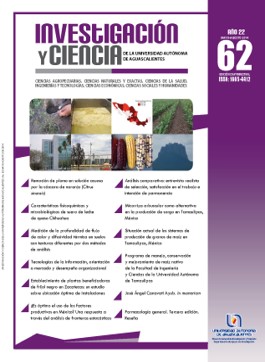Is the use of productive factors optimal in Mexico? A response through the stochastic frontier analysis
DOI:
https://doi.org/10.33064/iycuaa2014623634Keywords:
stochastic frontier analysis, technical efficiency, federal entities, production function, Batesse and Coelli, inefficienciesAbstract
The objective of this research is to analyze the technical efficiency for federal entities in Mexico and determine if an optimal use of production factors are being done. The methodology to be used is the stochastic frontier analysis. The main results are that the technical efficiency average is 72 percent, in real terms, which shows the potential that these economies still have to improve the use of factors. The efficiency indicator shows that the federal entities that make better use of their productive factors are Mexico City, the state of Mexico and Guanajuato, which have significantly reduced their inefficiencies in its use.
Downloads
References
ÁLVAREZ, I. et al. The effect of infrastructures on Total Factor Productivity and its Determinants: A study on Mexico. Revista Estudios Económicos, 26(1 enero-junio): 97-122, 2011.
• BATTESE, G. y COELLI, T. A model for technical inefficiency effects in a stochastic frontier production function for panel data. Empirical Economics, 20, 325-332, 1995.
• BATTESE, G. y COELLI, T. A Stochastic Frontier Production Function incorporating a model for technical inefficiency effects. Working Paper in Econometrics and Applied Statistics 69/93. Department of Econometrics, University of New England, 1993.
• BATTESE, G. y COELLI, T. Frontier production functions, technical efficiency and panel data: with application to paddy farmers in India. Journal of Productivity Analysis, 3: 153-169, 1992.
• BATTESE, G. Y COELLI, T. Prediction of firm-level technical efficiencies with a generalized frontier production function and panel data. Journal of Econometrics, 38: 387-399, 1988.
• BATTESE, G. et al. Estimation of frontier production functions and the efficiencies of Indian farms using panel data from ICRISAT´S Village level studies. Journal of Quantitative Economics, 5: 327-348, 1989.
• BATTESE, G. y CORRA, G. S. Estimation of a production frontier model: with application to the pastoral zone of Eastern Australia. Australian Journal of Agricultural Economics, 21:. 169-179, 1977.
• BECERRIL, O. et al. Disparidades en eficiencia técnica e influencia de las infraestructuras sobre la convergencia en eficiencia en México. Investigaciones Regionales. Mayo: 51-69, 2009.
• BECERRIL, O. et al. Eficiencia técnica de las entidades federativas de México. Revista Economía, Sociedad y Territorio, mayo-agosto 2010(33), 2010.
• BECERRIL, O. et al. Disparidades en eficiencia técnica y convergencia en eficiencia en México: un análisis de frontera. Quivera, Julio-Diciembre, 2007-29( 002): 131-154, 2007.
• BECERRIL, O. et al. Frontera tecnológica y Productividad total de los Factores de las Regiones de México. Región y Sociedad, 26(57. Mayo-agosto): 5-26, 2013.
• BECERRIL, O. U. y MUNGUÍA, G. Efecto de la globalización sobre la Eficiencia Técnica en el contexto regional de Colombia. Revista AD-minister, 22 enero-junio, 2013.
• CHÁVEZ, J. C. y FONSECA, F. J. Eficiencia Técnica y Estructural de la industria manufacturera en México: un enfoque regional. Banco de México. Working paper 2012-03. Mayo 2012.
• COELLI, T. A guide to Frontier Version 4.1.: a computer program for stochastic frontier production and cost function estimation. CEPA Working Paper 96/07. 1996.
• CHORTAREAS, G. E. et al. Desempeño del Sector Bancario en Algunos Países Latinoamericanos: Poder de Mercado versus Eficiencia. Documento de trabajo No. 2010-20.Banco de México. 2007.
• DELGADO, M. J. y ÁLVAREZ, I. Eficiencia técnica y convergencia en los sectores productivos regionales. Investigaciones Regionales. Otoño, Número 033. 2003.
• FARRELL, M. J. The measurement of productive efficiency. Journal of the Royal Statistical Society,120(Part. 3): 253-290, 1957.
• FERRO, G. et al. Eficiencia y su medición en prestadores de servicios de agua potable y alcantarillado. CEPAL. División de Recursos Naturales e Infraestructura. Documentos de proyectos No. 385. 2011.
• INEGI (INSTITUTO NACIONAL DE ESTADÍSTICA Y GEOGRAFÍA). Censos Económicos 2004. México: Autor. 2004.
• INEGI (INSTITUTO NACIONAL DE ESTADÍSTICA Y GEOGRAFÍA). Censos Económicos 2009. México: Autor. 2009.
• INEGI (INSTITUTO NACIONAL DE ESTADÍSTICA Y GEOGRAFÍA). Productividad Total de los Factores. Modelo KLEMS. Boletín de
investigación número 02/13. Aguascalientes, México: Autor. 2013.
• KODDE, D. A. y PALM, F. C. Notes and comments Wald criteria for jointly equality and inequality restrictions. Econometrica, 54(5): 1243-1248, 1986.
Downloads
Published
How to Cite
License
Copyright (c) 2014 Osvaldo U. Becerril Torres, María del Rosario Demuner Flores

This work is licensed under a Creative Commons Attribution-NonCommercial-ShareAlike 4.0 International License.
Las obras publicadas en versión electrónica de la revista están bajo la licencia Creative Commons Atribución-NoComercial-CompartirIgual 4.0 Internacional (CC BY-NC-SA 4.0)









